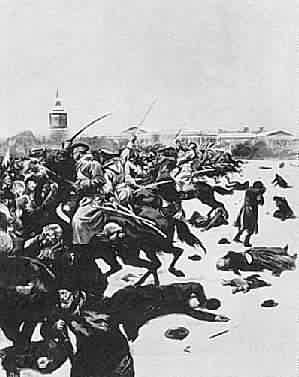Shostakovich’s bitter Eleventh proves a bitter disappointment with Bychkov
In Bela Tarr’s movie Werckmeister Harmonies, there is a scene of a mob of men marching with resolute determination towards a destination where they will wreak distubring violence. They are silent, the only sound the incessant stomping of their boots. It lasts for an unusually long time, this single tracking shot, and when asked to explain the scene’s duration, Tarr responded “that’s how long it took to get there.”
The same is true for Shostakovich’s Symphony No. 11, at least on the page. The music unfolds steadily across long stretches of time, using quiet, simple, slowly shifting chords, punctuated by ominous rhythms in the timpani and distant trumpet calls. It varies between stillness and explosion. It has a direction and a purpose and lasts just as long as it takes to get to its point. Like Tarr’s movie, it uses unexpected means to clearly express disturbing meanings, and amidst the greatness of Shostakovich’s symphonic compositions it is a relatively unknown and sadly underperformed masterpiece. It also marks the beginning of his mysterious, stone-faced late style.
And because of the means and quality of the music, the New York Philharmonic’s Thursday night performance under the baton of visiting conductor Semyon Bychkov was that much more disappointing. The musicians had plenty of energy and were mostly proficient, but Bychkov’s conception and leadership rendered the composer’s eloquence largely incoherent.
The symphony presents the same challenge as Mahler’s Symphony No. 9, where a misstep at the start is liable to wreck the whole thing. And indeed things went wrong right from the beginning. Bychkov’s opening tempo was too fast, an allegro when the movement is marked adagio. Shostakovich was a master of building intensity via music that is quiet and slow, and the indicated tempo is there to let the music develop a sense of foreboding until it can’t help but explode into outrage and anguish. Bychkov made it sound perfunctory, like a superficial effect.
His tempos were consistently too fast. The symphony is long, but it works better when it takes its time, when it compels the listener into its world. Then it is gripping. This performance, relatively quick by the clock, was tedious and felt far too long.
It was also too loud, the opening pianissimo edging past mezzo-forte. This piece has some of the most immediate and extreme juxtapositions of dynamics in the classical literature and Shostakovich used them to create both drama and a complex emotional and compositional structure. He worked the relatively minimal amount of musical material into a substantial and powerful whole by mainly using dynamics and tempo, together. Bychkov did build loud, dramatic climaxes, but he never created the context in which they would be meaningful.
The symphony asserts that it is a depiction of the 1905 massacre of peasants in front of the Winter Palace, but it’s mostly an undisguised statement about murderous totalitarianism and the possibility that, through determination and eloquence, humanism might prevail.
Bychkov never set the scenes, there was no mist rising in the early morning cold, no Potemkin-steps violence. The shallow, brittle acoustic of Avery Fisher Hall was no help; it was impossible to hear any space between the strings and the brass playing nineteenth-century revolutionary melodies in the quiet movements. The woodwinds respond to those themes, but there was no antiphony, just compression. With no depth of sound there was no atmosphere, no Shostakovich.
Before intermission, Kirill Gerstein joined the orchestra as soloist in Rachmaninoff’s Rhapsody on a Theme of Paganini.It was odd but ultimately winning. Gerstein – a dexterous, witty, elegant musician – carried the piece halfway on his own. Tempos again were a problem, with the pianist always a noticeable shade ahead of everyone else. His playing was brilliant, and the piano was so much louder and brighter than the entire orchestra that he won the argument.
But in variation twelve, something of a late night café song, everything came together; the balance problems were solved, the tempo was agreeable all around, and, with orchestra and pianist able to hear each other, they began to play with each other. From that point the music-making was satisfying. The crashing cliché of variation eighteen went by with a welcome minimum of schlag. For this showy, sentimental music it was surprisingly self-effacing, something the second half desperately needed.
This program is repeated 2 p.m. Friday and 8 p.m. Saturday at Avery Fisher Hall. nyphil.org



